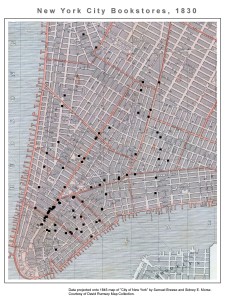For the SHARP conference in July 2013, I partnered with Jim Green and Paul Erickson on a panel exploring the physical and social spaces of 18th and 19th century American bookstores. Michael Winship chaired the panel, which was also sponsored by the Bibliographical Society of America. The panel description and an abstract of my presentation appears below.
SHARP 2013 Panel
Selling Spaces: Geographies of the Bookstore in 18th and 19th Century America
This panel engages the spatial dimensions of book history by focusing on one space—the bookstore—in 18th and 19th century America. The topographies and contours of retail bookselling in America before 1900 remain buried beneath dominant narratives such as the rise of the big-house publisher and larger-than-life individuals like Parson Weems. Yet it is during this period that retail booksellers emerged as significant participants in and arbiters of the American book market, developing professional and trade networks, experimenting with advertising and retail strategy, and acting as mediators between producers and consumers of books. This panel explores the spaces of retail bookstores with several broad questions in mind: How do we define “bookstore” in historical contexts? What methods and materials might we employ to study the retail business of print? And how would increased attention to retailing spaces and practices inflect our conceptions of “print culture”?
From the business practices of Benjamin Franklin’s colonial Philadelphia bookshop to antebellum New York City’s diverse and ever-shifting constellation of bookstores, from the interior layout of stores to the diverse wares sold to patrons, the bookstore is a key venue in the social and cultural geographies that organized individuals’ relationships to print, to forms of knowledge, and to the environments in which they moved. In exploring and mapping the space of the bookstore, this panel is interested in a broad approach to geography—in considering the interplay of social, economic, and trade geographies that emerged from bookstores, as well as the functions of physical space and cartographies of location in impacting the relationship between the individual and the book. Considered together, the papers of “Selling Spaces” argue for the crucial role of bookstores in shaping the cultural geographies that animated 18th and 19th century America.
Mapping the Bookstore: Retail Cartographies in Antebellum New York City
Kristen Doyle Highland, SHARP 2013
Using data collected from city directories, advertisements, and book catalogs with Geographic Information Systems (GIS) software, this presentation introduces original maps depicting the locations, movements, and patterns of retail bookstores in antebellum New York City. My talk will include analysis of these maps, along with evidence from news articles, city guides, and bookseller memoirs, to offer new insights into several aspects of nineteenth-century American print culture, including the development of specific book retailing strategies, the diverse forms of retail book outlets, and the roles of bookstores in the everyday cultural lives of urban residents.
Examinations of historical retailing practices remain underrepresented in book history studies. Yet it was more than the increased output of New York City’s publishing presses or innovations in printing and binding that transformed the city into a literary capital by the mid-nineteenth century. Bookstores—their locations and appearances, their stock and sales methods, as well as the people who operated them and the customers who patronized them—were significant participants in and shapers of New York’s literary and print culture. These stores, to use book historian Adrian Johns’ words, demonstrate “print culture in the making.” As Johns reminds us, the collected products and practices that compose “print culture” accrue significance and meaning only through “the hard, continuous work of real people in real places.”
Locating retail booksellers—the “real people” and “real places”—in the dynamic landscape of antebellum New York will help us survey a significant commercial and cultural aspect of the book trades during a seminal period in American literary production as well as the diverse contributions of bookstores to nineteenth-century urban life. More than simply a story about one place in one time—though it is that as well—antebellum New York City bookstores tell us about the textures of urban culture in a rapidly expanding metropolis and the values and forms of a literary marketplace that sold more books to more people than ever before.
